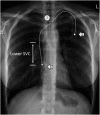Search pattern training for evaluation of central venous catheter positioning on chest radiographs
- PMID: 29564369
- PMCID: PMC5852256
- DOI: 10.1117/1.JMI.5.3.031407
Search pattern training for evaluation of central venous catheter positioning on chest radiographs
Abstract
The goal of this research was to examine whether search pattern training for central line positioning on chest radiographs (CXRs) improves the ability of healthcare trainees and practitioners to identify malpositioned central venous catheters. Two sets of CXRs with central catheters were shown; half of the images contained catheters that were appropriately positioned, half that were malpositioned. Subjects were asked to: mark the tip of the catheter using the simulated radiology workstations, indicate their confidence in tip localization, and state whether the catheter was appropriately positioned or malpositioned. Subjects were also given a survey assessing their thoughts about the usefulness of search pattern training and the simulated radiology workstation. There was a significant improvement in subjects' ability to classify a catheter as malpositioned after training, [Formula: see text]-value = 0.03. There was no significant difference in localization of the catheter tips or in the confidence for tip localization. Subjects' responses to the questionnaire were significantly positive for all statements, indicating that they felt search pattern training using a simulated radiology workstation had a positive impact on their education. These results suggest that our knowledge of medical image perception may be useful for developing rational educational tools for image interpretation, and that simulated radiology workstations may be a helpful means of deploying these tools.
Keywords: education; imaging; perception; radiology; training.
Figures




Similar articles
-
Teaching search patterns to medical trainees in an educational laboratory to improve perception of pulmonary nodules.J Med Imaging (Bellingham). 2016 Jan;3(1):011006. doi: 10.1117/1.JMI.3.1.011006. Epub 2015 Nov 6. J Med Imaging (Bellingham). 2016. PMID: 26870749 Free PMC article.
-
Simulation for Teaching and Assessment of Nodule Perception on Chest Radiography in Nonradiology Health Care Trainees.J Am Coll Radiol. 2015 Nov;12(11):1215-22. doi: 10.1016/j.jacr.2015.07.014. Epub 2015 Sep 28. J Am Coll Radiol. 2015. PMID: 26421854
-
Tip position of long-term central venous access devices used for parenteral nutrition.JPEN J Parenter Enteral Nutr. 2007 Sep-Oct;31(5):382-7. doi: 10.1177/0148607107031005382. JPEN J Parenter Enteral Nutr. 2007. PMID: 17712146
-
Imaging Approach to Misplaced Central Venous Catheters.Radiol Clin North Am. 2020 Jan;58(1):105-117. doi: 10.1016/j.rcl.2019.08.011. Radiol Clin North Am. 2020. PMID: 31731895 Review.
-
[Assessment of correct positioning and complications after insertion of central venous catheters using chest radiography].G Ital Nefrol. 2013 Nov-Dec;30(6):gin/30.6.1. G Ital Nefrol. 2013. PMID: 24402655 Review. Italian.
Cited by
-
Perceptual training and teaching medical students how to window and level chest radiographs.J Med Imaging (Bellingham). 2023 Feb;10(Suppl 1):S11907. doi: 10.1117/1.JMI.10.S1.S11907. Epub 2023 Apr 26. J Med Imaging (Bellingham). 2023. PMID: 37122685 Free PMC article.
-
Eye Tracking for Deep Learning Segmentation Using Convolutional Neural Networks.J Digit Imaging. 2019 Aug;32(4):597-604. doi: 10.1007/s10278-019-00220-4. J Digit Imaging. 2019. PMID: 31044392 Free PMC article.
-
Perceptual training: learning versus attentional shift.J Med Imaging (Bellingham). 2020 Mar;7(2):022407. doi: 10.1117/1.JMI.7.2.022407. Epub 2019 Dec 31. J Med Imaging (Bellingham). 2020. PMID: 31903409 Free PMC article.
-
Cognitive processing differences of experts and novices when correlating anatomy and cross-sectional imaging.J Med Imaging (Bellingham). 2018 Jul;5(3):031411. doi: 10.1117/1.JMI.5.3.031411. Epub 2018 May 18. J Med Imaging (Bellingham). 2018. PMID: 29795777 Free PMC article.
-
RadSimPE - a Radiology Workstation Simulator for Perceptual Education.J Digit Imaging. 2021 Aug;34(4):1059-1066. doi: 10.1007/s10278-021-00489-4. Epub 2021 Jul 29. J Digit Imaging. 2021. PMID: 34327629 Free PMC article.
References
-
- Krupinski E. A., “Current perspectives in medical image perception,” Atten. Percept. Psychophys. 72(5), 1205–1217 (2010).https://doi.org/10.3758/APP.72.5.1205 - DOI - PMC - PubMed
-
- Kundel H. L., “History of research in medical image perception,” J. Am. Coll. Radiol. 3(6), 402–408 (2006).https://doi.org/10.1016/j.jacr.2006.02.023 - DOI - PubMed
-
- Auffermann W. F., et al. , “Simulation for teaching and assessment of nodule perception on chest radiography in nonradiology health care trainees,” J. Am. Coll. Radiol. 12(11), 1215–1222 (2015).https://doi.org/10.1016/j.jacr.2015.07.014 - DOI - PubMed
-
- Auffermann W. F., Little B. P., Tridandapani S., “Teaching search patterns to medical trainees in an educational laboratory to improve perception of pulmonary nodules,” J. Med. Imaging 3(1), 011006 (2016).JMEIEThttps://doi.org/10.1117/1.JMI.3.1.011006 - DOI - PMC - PubMed
-
- Paoletti F., et al. , “Central venous catheters. Observations on the implantation technique and its complications,” Minerva Anestesiol. 71(9), 555–560 (2005).MIANAP - PubMed
LinkOut - more resources
Full Text Sources
Other Literature Sources

